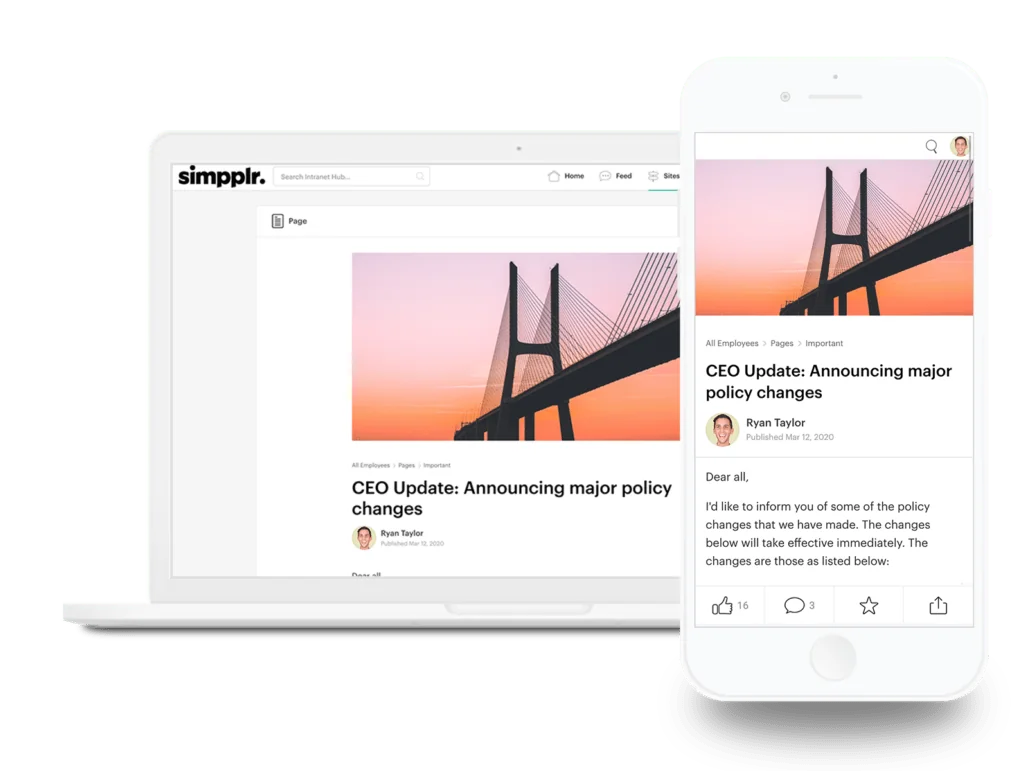Monday, March 23
This week officially marks the second week of the mandated “shelter in place.” I’m alive and kicking, and to my delight, this new work from home lifestyle isn’t too bad for an introvert like me. (Anyone else?)
Connecting with my immediate team hasn’t been a challenge since instant messaging apps like Slack are a part of the digital workplace. Setting meetings with my team has also been seamless using a video conferencing tool, like Zoom. However, I’m beginning to feel disconnected from the rest of my company. Another frustration I have is sifting through emails and Slack to find official, up-to-date communications from my CEO regarding the current environment. I’m hearing different news across all channels.
Ok, I am feeling lost and disconnected from my broader company. And maybe you are too. Having multiple kinds of technology is absolutely critical to empower employees to work productively, but we must understand how to utilize and leverage each tool for optimal performance without neglecting our social needs.

A guide to working from home using Slack, Zoom, intranet, and productivity suites
Remote work is not a new phenomenon. In fact, FlexJobs has reported that remote work has been increasing over the decade. Today, 3.4% of the U.S. population (or 4.7 million) work remotely. Technological advancements have aided and fueled the remote workforce, allowing people to work for companies all over the globe. The challenge with technology today is understanding how to utilize and leverage each technology so that we are productive, efficient, and connected.
Types of technology to enable remote work
Video conferencing apps

Video conferencing apps are a fantastic way to meet people if you’re unable to meet them in-person. Video conferencing apps, such as Zoom, replace the in-person meetings because it’s extremely easy to launch the app in a click of a button and see the other person right on your computer screen.
When to use video conferencing apps:
Instead of drafting a long email, it’s much easier and more comprehensible to have a 5-minute conversation. There is an immediate two-way conversation, and you’re able to make a stronger connection with whoever is on the other side. Humans have the innate ability to pick up and process facial expressions and body language immediately, so it helps understand you understand the situations without underlying assumptions like you would have in an email or a message. It’s also a plus to get to see your coworkers face-to-face if you haven’t seen them in weeks.
Most effective: Meeting face-to-face, longer conversations, replacing in-person meetings
Popular tools: Zoom, Google Hangouts, Skype, GoToMeeting
Instant messaging apps
Instant messaging has been around for quite some time, and even longer in our personal lives. Instant messaging tools are a great way to get immediate feedback without having to schedule a meeting, accept the invitation, and turn on our video cameras.
When to use instant messaging apps:
Instant messaging in the workplace is used in the same manner as we send text messages in our personal lives. They’re quick, give immediate answers, and are only effective if both people respond. However, instant messaging is not effective for longer, more complex conversations or if there are more than 2 people involved. Longer conversations and larger groups require more attention to detail which can be easily missed or misunderstood when text is sent back and forth.
Most effective: Immediate responses, short conversations, team collaboration
Popular tools: Slack, Microsoft Teams, Google Hangouts Chat, Hipchat
Productivity suites
Productivity suites are a group of applications from a single company, such as Office 365 and Google Suite. Productivity suites typically include programs such as a word processor, email service, and other productivity tools. Because all of these programs are under one umbrella, productivity suites make it seamless to collaborate and share information specific to the application used. Productivity suites are generally excellent for collaboration across departments, but they do not address a company’s need for an internal communication platform.
When to use productivity suites:
Productivity suites are extremely helpful in housing work documents because applications are centralized. This allows employees to find and access documents and files without looking across different locations. Productivity suites are fantastic at enabling employees to collaborate in real-time, without the need to meet in-person, or dial into a conference call. Generally, when employees use their productivity suite, they already have enough information to begin reviewing documents, such as documentation. Simpplr recommends Google Suite because it’s cloud-based, easy-to-use, and does not require much training. If you’re already using another productivity suite, the rule of thumb is to stick with and use one (across the company). That way, you keep everything in one place.
Most effective: Real-time collaboration, drafting and reviewing documents, centralizing employee apps, increasing work visibility, sharing and storing documents, improving productivity between employees and across teams
Popular tools: Office 365, Google Suite
Employee Intranet

So far, we’ve talked about video conferencing apps, instant messaging tools, and productivity suites, but none of these technologies have addressed the human need for belonging and fulfillment. These are important to address because it relates to engagement and culture, which impacts a company’s overall performance. Oftentimes, the social needs of employees are overshadowed by business-oriented values such as productivity and efficiency, especially in this unprecedented time. It’s important to understand how culture and engagement impact employee and company performance.
The intranet is the ideal technology to continually enforce purpose, drive alignment, and build community. When it comes to staying connected with your broader company, emails, productivity suites, and video conferencing tools can only extend so far because they are not designed to streamline communication from the top-down. Not all communications through those channels are meant for all employees, and when people are forced to find and sift through irrelevant content, it becomes frustrating for employees. And irrelevant messages become noise.
It’s important to note that not all intranets are created equal. Modern intranets are designed with today’s workforce and user experience in mind. Unlike older, traditional intranets, today’s’ modern intranets are flexible enough to meet the demands of the evolving workforce. Modern intranets must:
- Power your workforce to go at the speed of business. Old intranet models create technical bottlenecks.
- Enable you to post critical updates immediately. Traditional intranets are hard-to-use, with some requiring technical chops.
- Not force tradeoffs. Older intranets may keep documents up-to-date, but they lack the functionality to connect you with experts across your organization.
When to use the intranet:
The modern intranet is uniquely positioned to address communication gaps that are overlooked in the technology stack. While other software is designed for employee-to-employee communication and collaboration, the intranet is purposefully designed to streamline critical top-down communications. Intranets do not try to replace any of the existing technologies. Rather, modern intranets connect your digital workplace through integrations to drive employee productivity and maintain a single source of truth.
In uncertain times when a large percentage of the workforce is mandated to work from home, employees need (1) to feel connected to the broader organization and (2) leaders to guide and strengthen morale. Based on Simpplr Research, we know the top drivers of culture. Top drivers of culture are:
- Purpose
- Alignment
- Community
Most effective: Connecting employees to the broader organization, streamlining critical top-down communications, aligning the entire organization quickly, providing a single source of truth for employees, serving as a virtual headquarters for remote employees
Popular tools: Simpplr
Assembling your remote work tools

By now, most organizations have a technology stack or a digital workplace for employees to work remotely from home amid COVID-19. Most of our customers already have a video conferencing tool, an instant messaging app, and a productivity suite, come to us for an internal communication platform to streamline communications across the organization. We believe that having these types of remote working tools is critical for remote productivity and offer integrations to each of these applications. These types of software enable the workforce to work productively together, but not without an internal communication platform to align, connect, and engage your remote workforce. Without it, there becomes a gap in the communication infrastructure, leaving your employees to feel disconnected and lonely.
Simpplr is offering a Rapid Deployment Solution that guarantees full deployment in 2 weeks. For more information, visit Simpplr’s Rapid Deployment Solution.
Subscribe to our Work from Home Diary Series:
Read through Simpplr’s work from home diary blog series and learn how you can maintain workplace culture during this mandated work from home time.
Day 1: Shift to Work from Home
Day 2: How Employees Can Stay Focused
Day 3: How to Work from Home with Kids
Day 4: Work from Home Setup Tips & Ideas
Day 5: Engage Your Remote Employees with Fun Social Activities

















